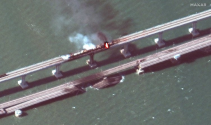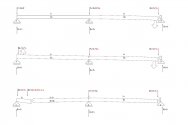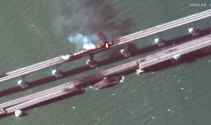You are using an out of date browser. It may not display this or other websites correctly.
You should upgrade or use an alternative browser.
You should upgrade or use an alternative browser.
The War in the Ukraine
- Thread starter SampanViking
- Start date
flying in Belarus can make them see what is arriving in Poland. its another matter where to strike to maximize the skilled human toll at minimum cost and without revealing more than necessary. they were doing these things years ago. infact they mentioned Su-34 and PAKAF has similar ability as electronic get compact.50 km behind the front is nothing. Even 200 km behind the front is nothing. Russia needed to see maneuvers from Lviv to Kharkov. They did not.
As i said Yemen, Syria, Irak, Libya are very different battlefields and Russia has hand in all of them. It is Middleast to balance favoring one side they have to provide real help to another side in another place. It is a real experience on ground.
Patchwork was an allege PLA/Military analyst contractor or something in that realm whom worked for the US government or an MIC. He left after members repeatedly asked for confidential information about the f-22/f-35
If memory serves me right, i think it was more of a data analyst rather than a military analyst based on what he said. Tho not like that matters anymore since his other account is also gone to now. However, he did specifically say his military analysis was more of a hobby and it should be taken with a grain of salt quite a few times.
If the "grand bargain" was his goal, then he should have blitzkrieg'd Ukraine, do his gas shennanigans in response to sanctions immediately (not allowing European countries to fill their gas reserves even a tiny bit after they started economic warfare), and negotiate from the position of strength - it would re-affirm Russian military prowess and also make the current energy crisis even more dire for Europe. It would be far harder for the West to maintain their support and take economic damage if Ukraine was already non-existent. Instead, he half-assed both battlefields.I have long had the feeling that Putin is obviously waiting for something, everything seems to me like a strategic expectation, otherwise I can't explain all this passivity during a "special military operation.
How do you expect Putin to re-negotiate a better deal under the current situation? NATO is smelling blood in the water and their actions are getting more & more bold - first blowing up pipelines with Polish official directly saying "thanks USA", now bombing of Crimean bridge with Ukraine basically saying "yeah we did this" (and only half-assedly try to shift the blame later, fooling no one). The only deal that NATO will negotiate now is how many states Russia will be split into.
Last edited:
Dreams are free!
Indeed, they are. One should not confuse their personal bias filter for reality.
@Biscuits : It appears the Ukrainians are conceding it was a truck bomb per NYT. It looks weird to me still, but I concede you are correct.
Sky News’s defense analyst Micheal Clarke made the claim that a truck bomb would not have the capability to inflict the sort of damage brought upon the bridge. He insists it was either a missile or a SpecOps operation.
I guess he never saw the size of the alleged truck: it could easily have contained 20-30 times the explosive of Tomahawk class cruise missile. If anything, the damage is smaller than one would expect of a large truck bomb. Just compare to the devastation of the Oklahoma city bombing.
He might still be right about it not being a truck bomb, but for the wrong reasons.
I guess he never saw the size of the alleged truck: it could easily have contained 20-30 times the explosive of Tomahawk class cruise missile. If anything, the damage is smaller than one would expect of a large truck bomb. Just compare to the devastation of the Oklahoma city bombing.
He might still be right about it not being a truck bomb, but for the wrong reasons.
Last edited:
Satellite photos show a heavily charred road surface on both parts of the collapsed span.Since I don't believe (not yet at least) that it was a truck bomb and believe the explosion came from under the bridge, what if the rail bridge pillars were the target and not the road bridge?
Maybe the drone boat/submersible accidently struck the road pillar setting it off.
A downward force from a truck bomb could have lifted the span at the joint and caused it to bend the way it did.
Amazing what passes for a "defence analyst" in the west these days. Does he really think a missile can carry the same payload as a HGV?Sky News’s defense analyst Micheal Clarke made the claim that a truck bomb would not have the capability to inflict the sort of damage brought upon the bridge. He insists it was either a missile or a SpecOps operation.
I guess he never saw the size of the alleged truck: it could easily have contained 20-30 times the explosive of Tomahawk class cruise missile. If anything, the damage is smaller than one would expect of a large truck bomb. Just compare to the devastation of the Oklahoma city bombing.
He might still be right about it not being a truck bomb, but for the wrong reasons.
If true, I didn't expect Putin to be this pathetic...
Pathetic isn't quite the word I'd use, but...apparently someone else in the Russophonic warblogosphere has a pretty impressive rant:
Sky News’s defense analyst Micheal Clarke made the claim that a truck bomb would not have the capability to inflict the sort of damage brought upon the bridge. He insists it was either a missile or a SpecOps operation.
I guess he never saw the size of the alleged truck: it could easily have contained 20-30 times the explosive of Tomahawk class cruise missile. If anything, the damage is smaller than one would expect of a large truck bomb. Just compare to the devastation of the Oklahoma city bombing.
He might still be right about it not being a truck bomb, but for the wrong reasons.

For illustrative purposes only:
Below is a simplified static model of a span element supported in three points and with one of the supports destroyed.
Supports 1 and 2 are expansion joints. Length of span is L1+L2. Weight (load) is Q1+Q2 where load of L1 is Q1 and load of L2 is Q2. The force acting on supports is equal to the load Q divided by number of supports because loads are uniform and supports are symmetrical so we can ignore the distance from support for simplification. Every support generates a reaction force per Newton's third which is equal to the acting force.
First diagram shows the initial state before the explosion. This is how the bridge element was intended to be and all parameters were optimized to match this naturally with added safety margins. The graph below shows the function of stress amplitude generated by load.
Second diagram shows the state after the explosion. Span L2 is only supported by support 2 turning it into a cantilever where instead of a simple force we also have torque equal to force multiplied by distance. The graph below shows function of stress amplitude. Because there is only one support the maximum stress is at the free end of the span.

Third diagram shows changes to static model in red. The arrow indicates that the right end of the span begins to move down which will deform the spanning element and lift it from support 1. Force acting on support 2 is now increased which will impact how it behaves.
Fourth diagram shows what happens when the imbalance lifts the span from support 1 - it now turns to double cantilever resting with its entire load on support 2. This doubles the stress on the middle part of the span leading to its destruction which then causes loss of rigidity in the element. The left end falls back on the support with acceleration equal to g causing a dynamic force which is greater than static F1.
Fifth diagram shows what happens when the left end hits support 1. The element breaks in a weak point somewhere between the support and the middle of the span (I didn't calculate for simplicity). Both remaining ends of the span resting on support 2 collapse due to the destruction of the element above support 2.

This is precisely what is shown on the satellite image.
I will point out that in many bridges the spanning element often has greater height (thickness) in the middle - that's because the forces are (counterintuitively) greater in the middle because of geometry. This is also why the suspended element of the Crimean bridge has a high arc - it is an approximation of the same principle, the top of the arc is in the middle where the stress in the spanning element is greatest. Height of the section of the element is increased in the middle part so that it is more rigid where deformation is greatest. This has all to do with economy of building materials and construction. But because of that and somewhat counterintuitively structural elements are most vulnerable to damage near the support and not in the middle where the stress is nominally greatest.
The question is whether a truck bomb has sufficient energy to generate a shockwave capable of destroying the span element near support 3 or damaging it sufficiently that the load of the element will do the rest on its own. I am not an expert on explosives but I suspect that a shaped charge with explosive mass of 1-2t (or more) and shaped fragmentation to improve penetration which is perfectly plausible on a truck could damage it sufficiently. 1-2 t of modern explosives in a shaped charge that is delivered near the support could be sufficiently damaging especially if the structural element was optimized and is weaker near the support. I can't speak to the technical aspects of the explosion. My concern would be the driver - it would have to be remotely piloted truck with a mannequin for disguise. Is there security on the bridge? Would that be possible?
I've seen a clip on Twitter that allegedly showed a tactical missile hitting the bridge but it was too implausible. It looked too much like edited footage.
I am not convinced that 0,3t warhead of ATACMS is sufficient for this kind of damage even including kinetic energy from impact but that again depends on the actual structural parameters of the spanning element. Similarly an air-launched cruise missile - with deployment mechanism improvised like in the case of AGM-88 - is sufficient as it has sub-sonic velocity and 0,3-0,4t warhead at maximum.
Truck bomb would have an additional benefit of using a shockwave to convey damage rather than kinetic and blast energy. For that you would need to have the shaped charge at 2-2,5m above the road and perhaps compressed gas of some type underneath to increase the density of the air in the shockwave. That kind of explosion would deliver force at an area rather than a point. It could be a linear charge of 4-5 meters long that would explode directly above the support thus making sure that the shearing force is maximized.
All in all it is plausible from the structural point of view but need more information about the phyisical parameters of the blast and shockwave.
Of course that doesn't exclude a planted explosive underneath or an aerial strike or a submersible with a heavy explosive load surfacing near the support. That last instance would require greater explosive load because of distance from the joint. The explosion creates a shockwave - a pressured medium front moving at a velocity which is the main force carrier. An explosion from underneath differs from an explosion above in details. It is just as capable of destroying the joint.
That's it from me. You have the general model, the rest should be simple once more information is publicized.
One more thing - there was speculation that the rail link was attacked simultaneously. Personally I doubt it although there might have been some coordination. The fire was most likely caused by the explosion. The flame was red-yellow indicating low thermal load of the substance and slow oxidation. It burned the way gasoline burns - surface fire only. The steel railings were the only element deformed. From my end - I'd be more interested in placing the explosion in the right spot near the support than trying to match it to something happening on a parallel way. It was just lucky coincidence.

